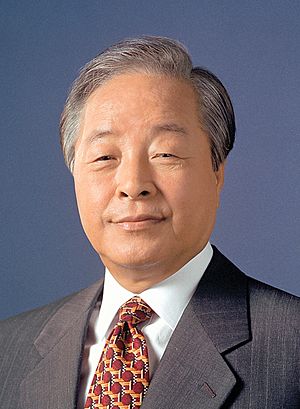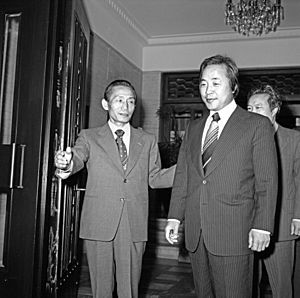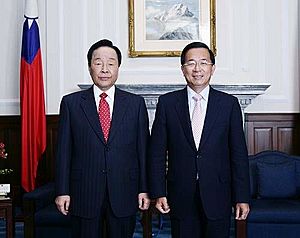Kim Young-sam facts for kids
Quick facts for kids
Kim Young-sam
|
|
|---|---|
|
김영삼
金泳三 |
|

Official portrait, 1993
|
|
| 7th President of South Korea | |
| In office 25 February 1993 – 24 February 1998 |
|
| Prime Minister | Hwang In-sung Lee Hoi-chang Lee Yung-dug Lee Hong-koo Lee Soo-sung Goh Kun |
| Preceded by | Roh Tae-woo |
| Succeeded by | Kim Dae-jung |
| President of the New Korea Party | |
| In office 28 August 1992 – 30 September 1997 |
|
| Preceded by | Roh Tae-woo |
| Succeeded by | Lee Hoi-chang |
| President of the Reunification Democratic Party | |
| In office 12 May 1988 – 22 January 1990 |
|
| Preceded by | Kim Myung-yoon |
| Succeeded by | Office abolished (party merger into DLP) |
| In office 1 May 1987 – 8 February 1988 |
|
| Preceded by | Office established |
| Succeeded by | Kim Myung-yoon |
| President of the New Democratic Party | |
| In office 7 June 1979 – 27 October 1980 |
|
| Preceded by | Lee Chul-seung |
| Succeeded by | Office abolished (party dissolution) |
| In office 21 August 1974 – 21 September 1976 |
|
| Preceded by | Kim Eui-taek |
| Succeeded by | Lee Chul-seung |
| Member of the National Assembly | |
| In office 30 May 1992 – 13 October 1992 |
|
| Constituency | Proportional Representation |
| In office 30 May 1988 – 29 May 1992 |
|
| Constituency | Seo (Busan) |
| In office 29 July 1960 – 4 October 1979 (expelled) |
|
| Constituency | Seo (Busan) |
| In office 31 May 1954 – 30 May 1958 |
|
| Constituency | Geoje (South Gyeongsang) |
| Personal details | |
| Born | 20 December 1927 Geoje, Geojedo, South Gyeongsang Province, Korea |
| Died | 22 November 2015 (aged 87) Seoul, South Korea |
| Resting place | Seoul National Cemetery, Seoul |
| Political party | Independent |
| Other political affiliations |
Liberal (1954) Democratic (1955-1960) Civil Rule (1963-1965) People (1965-1967) New Democratic (1967-1980) New Korean Democratic (1985-1987) Reunification Democratic (1987-1990) Democratic Liberal-New Korea (1990-1997) |
| Spouse | |
| Children | Kim Hye-young (daughter,1952) Kim Hye-jeong (daughter,1954) Kim Eun-chul (son,1956) Kim Hyun-chul (son,1959) Kim Sang-man (extramarital son,1959) Kim Hye-sook (daughter,1961) |
| Alma mater | Seoul National University (B.A.) |
| Religion | Presbyterianism (GAPCK) |
| Signature |  |
| Military service | |
| Allegiance | |
| Branch/service | |
| Rank | Student officer |
| Korean name | |
| Hangul | |
| Hanja | |
| Revised Romanization | Gim Yeongsam |
| McCune–Reischauer | Kim Yŏngsam |
| Art name | |
| Hangul | |
| Hanja | |
| Revised Romanization | Geosan |
| McCune–Reischauer | Kŏsan |
Kim Young-sam (Korean: 김영삼; Hanja: 金泳三; 20 December 1927 – 22 November 2015) was a South Korean politician and activist. He served as the seventh president of South Korea from 1993 to 1998.
For nearly 30 years, starting in 1961, he was a key leader of the opposition in South Korea. He stood against the strict governments of Park Chung-hee and Chun Doo-hwan. When he was elected president in 1992, Kim became the first civilian to hold this high office in over 30 years. He started his term on February 25, 1993. During his five years as president, he launched a big campaign against corruption. He also had his two previous presidents arrested. His government also introduced a policy called Segyehwa, which focused on making South Korea more connected globally.
Towards the end of his time as president, Kim faced criticism. This was partly due to the collapse of the Seongsu Bridge and the Sampoong Department Store. He was also blamed for a difficult economic period in South Korea during the 1997 Asian financial crisis. This crisis made South Korea take large loans from the International Monetary Fund (IMF). These loans came with strict conditions that many people disliked. Because of these issues, his approval rating was very low, around 6%.
Contents
Early Life and Education
Kim Young-sam was born on December 20, 1927, on Geoje Island in what was then Korea under Japanese rule. His family was wealthy and involved in fishing. He was the oldest of six children, with one son and five daughters.
During the Korean War, Kim served in the South Korean military as a student officer. In 1952, he earned a degree in Philosophy from Seoul National University.
Beginning His Political Journey
In 1954, Kim was elected to the National Assembly of South Korea. He was part of the party led by Syngman Rhee, South Korea's first president. At the time, Kim was the youngest member of the assembly.
Just a few months after his election, Kim left his party. He joined the opposition when President Rhee tried to change the country's constitution of South Korea. Kim then became a strong critic of the military governments led by Park Chung-hee and Chun Doo-hwan. He worked closely with Kim Dae-jung in this effort.
In 1969, Kim strongly opposed a plan to let President Park serve three terms. He also spoke out against Park's power grab with the strict Yushin Constitution in 1972. In 1971, Kim tried to become president himself against Park, but Kim Dae-jung was chosen as the opposition candidate instead.
Leading the New Democratic Party
In 1974, Kim was chosen to lead the New Democratic Party. He believed in a tough approach, refusing to work with Park's ruling party until the strict Yushin Constitution was removed. He openly criticized Park's rule, even though this could lead to imprisonment.
In August 1979, Kim allowed about 200 female workers to protest at his party's headquarters. Police raided the building, arresting the workers and injuring several lawmakers. This event, known as the YH Incident, caused widespread anger. Kim declared that Park's government would soon fall.
After this, Park tried to remove Kim from politics. When Kim told The New York Times that the United States should stop supporting Park's government, he was expelled from the National Assembly in October 1979. In protest, all 66 lawmakers from his party resigned.
This led to large protests in Kim's hometown of Busan. These demonstrations, called the Bu-Ma Democratic Protests, spread to other cities. Students and citizens demanded an end to the strict government. Amidst this unrest, Park Chung-hee was assassinated on October 26, 1979.
Under House Arrest
The new government under Chun Doo-hwan, who took power in a military coup in December 1979, continued to suppress opposition. Kim Young-sam was removed from the National Assembly and banned from politics from 1980 to 1985. In May 1983, he went on a 21-day hunger strike to protest Chun Doo-hwan's strict rule.
Presidential Election in 1987
In 1987, South Korea held its first democratic presidential election after Chun's retirement. Kim Young-sam and Kim Dae-jung both ran, which split the votes for the opposition. This allowed former general Roh Tae-woo, who was chosen by Chun, to win the election.
Joining the Ruling Party
On January 22, 1990, Kim merged his Democratic Reunification Party with Roh's ruling party, the Democratic Justice Party. They formed the Democratic Liberal Party. Many democratic activists were upset by Kim's choice, seeing it as a betrayal. However, Kim kept his support in Busan and Gyeongsang. He made this move to become Roh's successor, and in 1992, he became the presidential candidate for the ruling Democratic Liberal Party.
President of South Korea (1993–98)
As the candidate for the ruling party, Kim Young-sam won the 1992 South Korean presidential election. He defeated Kim Dae-jung and businessman Chung Ju-yung. He was the first civilian elected to a full term as president since 1960.
Government Reforms
Kim Young-sam's government worked to improve the government and the economy. One of his first actions was to start a campaign against corruption. He promised not to use secret political money. This campaign also aimed to reform the chaebols, which are large South Korean companies that control much of the economy.
His government made officials publish their financial records. They also introduced a "real-name" financial system. This made it hard to open bank accounts with fake names. This led to several high-ranking officials leaving their jobs. It also made it harder for big companies to give secret money to politicians. Kim also had the two previous presidents, Chun and Roh, arrested for their roles in military coups and corruption. Later, they were pardoned near the end of his term. Kim's government also went after leaders of big companies who had paid bribes.
Kim also removed politically active generals from a group called Hanahoe. This group had been very involved in government decisions. Kim disbanded Hanahoe, helping the military become less involved in politics. He also granted freedom to 41,000 political prisoners in March 1993. He cleared the records of pro-democracy protesters who had been arrested during the Gwangju massacre.
However, Kim's anti-corruption efforts faced a setback. His own son was arrested for issues related to the Hanbo scandal, which involved bribery and tax problems.
Economic Changes
Kim wanted big companies to become more efficient and competitive globally. This was a change from the past where the government directed economic growth. Kim introduced his "100-Day Plan for the New Economy" to lower inflation and stop company corruption. He also started a Five-Year Plan to attract more foreign investment. By 1996, the average income per person in South Korea was over US$10,000.
He also made changes to labor laws. These changes made it easier to dismiss workers and increased working hours. They also made it simpler to replace striking workers and prevented new unions from forming. These measures were passed quickly in Parliament in December 1996.
North Korea Relations
In 1994, during a nuclear crisis, US President Bill Clinton considered attacking Nyongbyon, North Korea's nuclear site. Kim advised Clinton not to attack, fearing it would start a war. Kim knew that South Korean cities would be attacked first if a war began. He felt it was important to stop any action that could lead to war.
Diplomacy with Japan
Kim took a very direct approach in his dealings with Japan. He famously said, "We will teach them to have manners once and for all." This was in response to Japanese politicians defending Japan's actions during World War II.
The 1997 IMF Crisis
Kim's final year as president was marked by a major economic crisis. By 1996 and 1997, many banks had bad loans because large companies were expanding too quickly. Kim's financial reforms in 1993 had allowed banks to grow and offer short-term loans, which led to companies borrowing a lot. Many businesses failed to make enough profit.
The Hanbo scandal in early 1997, which involved Kim's son, showed the world South Korea's economic problems and corruption. Hanbo was the first big company to go bankrupt in January 1997, starting a chain reaction. Kim's government seemed slow to act as the financial crisis grew. In July 1997, Kia Motors, a large car maker, asked for emergency loans. Kim's government refused to bail them out on their terms and took control of the company in October 1997. More large South Korean companies collapsed, causing interest rates to rise and international investors to pull out.
In November 1997, a credit rating agency lowered South Korea's rating, which made stock markets fall even more. For example, the Seoul stock exchange dropped by 7% on November 8. Other big companies were affected, like Samsung Motors and Daewoo, which was later sold to General Motors.
On November 22, 1997, Kim spoke to the nation on TV. He apologized and asked everyone to be careful with money. He blamed companies for borrowing too much and workers for asking for too much pay. He admitted his government didn't make strong enough reforms due to pressure from special groups. As a result, Kim's approval rating dropped to 6%, making him very unpopular.
On December 3, 1997, the International Monetary Fund (IMF) agreed to give South Korea US$58.4 billion in aid. In return, South Korea had to make big changes to its economy. The government closed or merged many struggling financial institutions. The value of the South Korean won currency dropped sharply but later recovered. South Korea's national debt also increased significantly because of the crisis.
Life After Presidency and Death
Kim Young-sam could not run for president again because the South Korean constitution limits presidents to one five-year term. His term ended on February 24, 1998. His political rival, Kim Dae-jung, became the next president. This was the first time in South Korea's history that power was peacefully transferred from one president to another from an opposing party.
After his presidency, Kim traveled the world. He promoted democracy and spoke at events, such as a forum on new democracies in Taiwan in January 2007.
Kim Young-sam passed away in Seoul National University Hospital on November 22, 2015, at the age of 87. He died from heart failure. On November 26, 2015, a state funeral was held for him at the National Assembly lawn. Later that day, Kim was buried in the Seoul National Cemetery alongside other former presidents.
Awards
National Honours
Foreign Honours
 Malaysia:
Malaysia:
 Peru:
Peru:
 Philippines:
Philippines:
 Poland:
Poland:
 South Africa:
South Africa:
 Spain:
Spain:
 Collar of the Order of Civil Merit
Collar of the Order of Civil Merit
 Ukraine:
Ukraine:
Personal Life
Kim Young-sam was a member of the Chunghyun Presbyterian Church. He spoke Japanese fluently, in addition to his native Korean. He was married to Son Myung-soon. He had two sons and three daughters, and five younger sisters.
See also
 In Spanish: Kim Young-sam para niños
In Spanish: Kim Young-sam para niños




